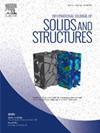受四维超立方体投影启发的具有可控机械特性的晶格超材料
IF 3.4
3区 工程技术
Q1 MECHANICS
International Journal of Solids and Structures
Pub Date : 2024-10-05
DOI:10.1016/j.ijsolstr.2024.113091
引用次数: 0
摘要
材料研究界对提高机械性能的可设计性越来越感兴趣。现有的方法通常采用复杂的算法(如机器学习)来反向设计具有特定性能的材料。与这些现有方法不同,我们在此提出了一种新方法,通过不断调整源自四维超立方体投影的独特单元拓扑的几何参数,来创建具有连续可控机械特性的晶格超材料。晶胞包含内部区域和外部区域,每个区域具有不同的变形特性。例如,内部区域是以拉伸为主的简单立方(SC)单元格,而外部区域则是以弯曲为主的体心立方(BCC)单元格。具体来说,可以同时实现刚度和强度的各向同性。所提出的晶格超材料具有引人入胜的双应力高原特性。通过调整内部和外部区域的几何参数,可以有效控制这些高原,从而使这些晶格超材料在能量吸收场景(如车辆和行人保护)中具有广阔的应用前景。这种晶格超材料设计可通过单元拓扑结构的连续转换实现力学性能的梯度分布,而不会引入低效界面,为涉及非均匀应力分布的异质超材料设计提供了一种新方法。本文章由计算机程序翻译,如有差异,请以英文原文为准。
Lattice metamaterials with controllable mechanical properties inspired by projection of four-dimensional hypercubes
There has been an increasing interest among the material research community in the pursuit of enhancing the designability of mechanical properties. The existing approaches usually resorted to sophisticated algorithms (such as machine learning) for the reverse design of materials with specific properties. Different from these existing approaches, here we propose a new approach to create lattice metamaterials with continuously controllable mechanical properties by continuously adjusting the geometric parameters of a unique cell topology originated from the projection of four-dimensional hypercubes. The cells contain an inner region and an outer region, each with different deformation characteristics. For example, the inner region is a stretching-dominated simple cubic (SC) unit cell, while the outer region is a bending-dominated body-centered cubic (BCC) unit cell. Specifically, both stiffness and strength isotropy can be simultaneously realized. The proposed lattice metamaterial exhibits intriguing feature of dual stress plateaus. These plateaus can be effectively controlled by adjusting the geometric parameters of inner and outer regions, which enables these lattice metamaterials to hold promising application prospects in the energy absorption scenarios, such as vehicle and pedestrian protection. Such lattice metamaterial design can be used to realize the gradient distribution of mechanical properties through continuous transition of cell topology without introduction of inefficient interfaces, providing a new approach for the design of heterogeneous metamaterials used in the scenarios involving non-uniform stress distribution.
求助全文
通过发布文献求助,成功后即可免费获取论文全文。
去求助
来源期刊
CiteScore
6.70
自引率
8.30%
发文量
405
审稿时长
70 days
期刊介绍:
The International Journal of Solids and Structures has as its objective the publication and dissemination of original research in Mechanics of Solids and Structures as a field of Applied Science and Engineering. It fosters thus the exchange of ideas among workers in different parts of the world and also among workers who emphasize different aspects of the foundations and applications of the field.
Standing as it does at the cross-roads of Materials Science, Life Sciences, Mathematics, Physics and Engineering Design, the Mechanics of Solids and Structures is experiencing considerable growth as a result of recent technological advances. The Journal, by providing an international medium of communication, is encouraging this growth and is encompassing all aspects of the field from the more classical problems of structural analysis to mechanics of solids continually interacting with other media and including fracture, flow, wave propagation, heat transfer, thermal effects in solids, optimum design methods, model analysis, structural topology and numerical techniques. Interest extends to both inorganic and organic solids and structures.

 求助内容:
求助内容: 应助结果提醒方式:
应助结果提醒方式:


